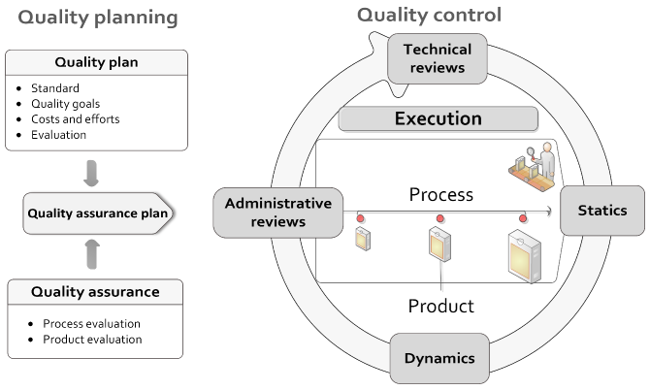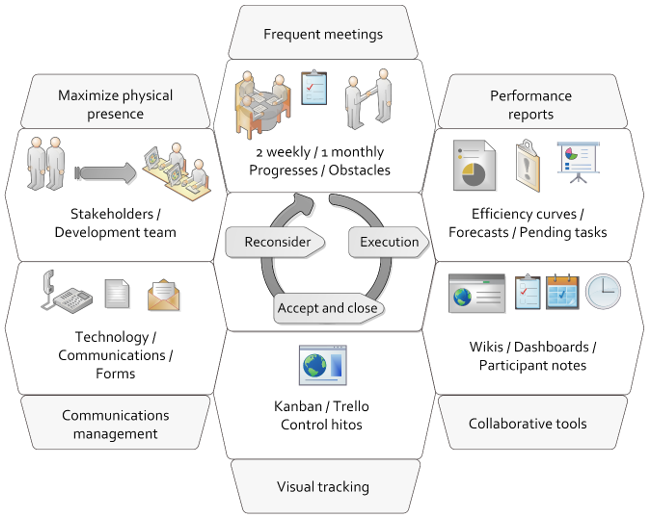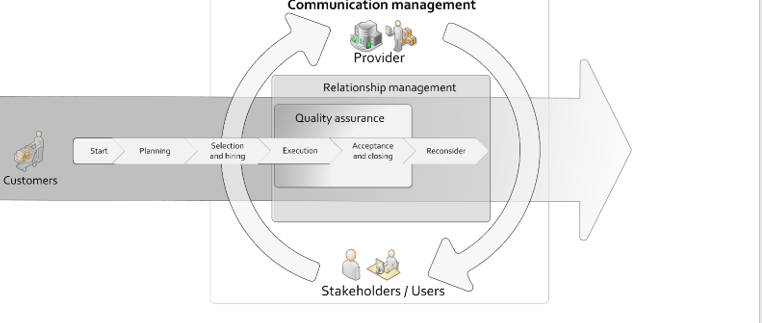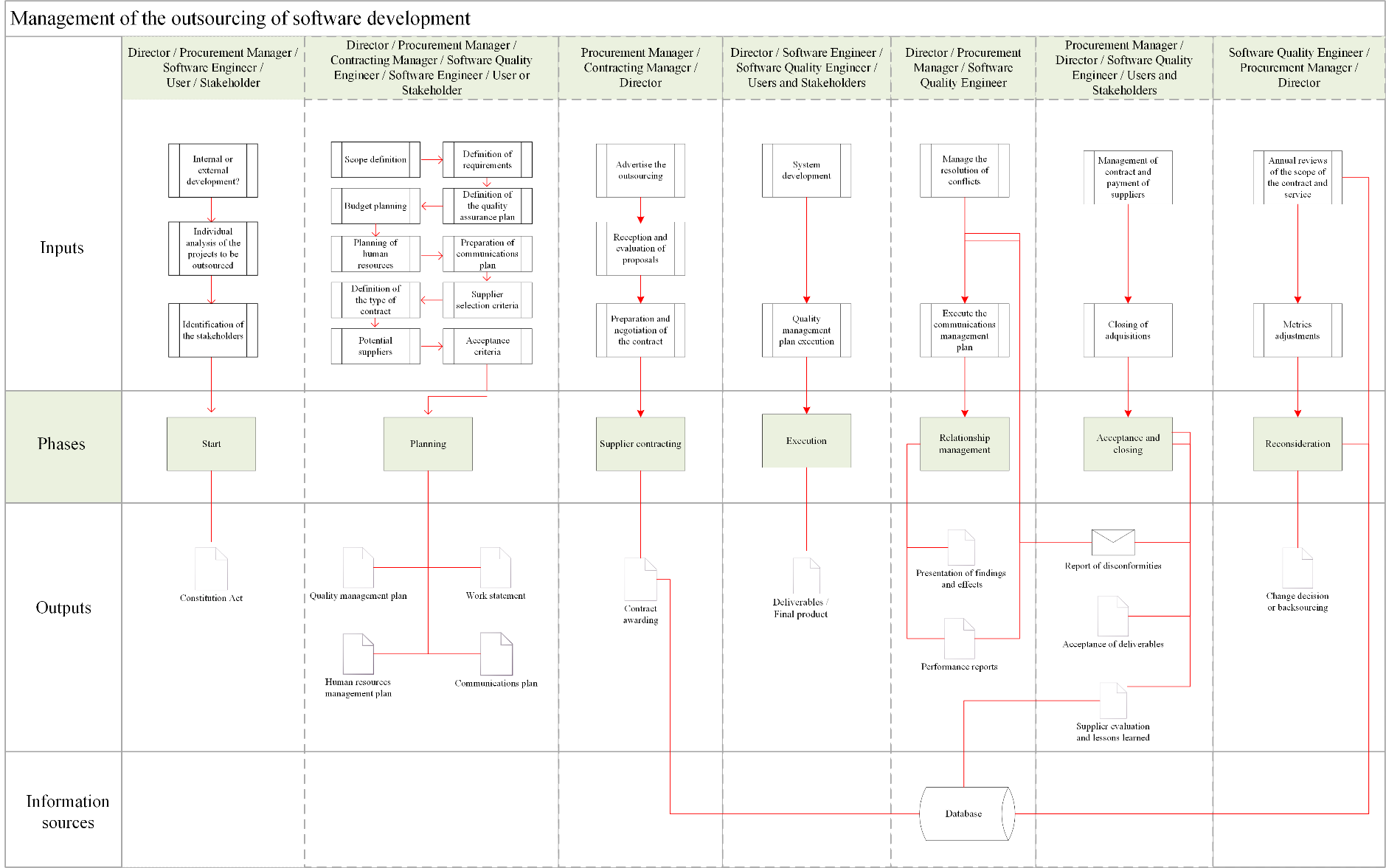This section presents the proposal of a methodology to aid the management of outsourcing processes based on the review carried out in section 2. The procedure synthesizes the fundamental phases for this type of process. It considers seven stages that contemplate aspects to improve the communication, active participation of the parties, and the quality of the final product:
1. Start
2. Planning
3. Selection and hiring of the supplier
4. Execution
5. Managing the relationship with the provider
6. Acceptance and closing
7. Reconsideration
The flow of the procedure and the relationship between the phases is shown in Figure 1 with a special emphasis on communication management, relationship management, and quality assurance.
It is important to consider the special role of Communication management, Relationship management and Quality assurance. Communication management must be performed during almost all phases of outsourcing (except the Start and Planning phases) and includes relationship management and quality assurance. It aims to guarantee better communication between the customer and the supplier through tools, methods, and techniques that facilitate the exchange of information from the initial stages of the system development.
Concurrently, the administration of the relationship seeks to improve the connection between the supplier, users, and stakeholders to enhance the understanding of needs, monitor progresses during development, and evaluate product deliveries. Similarly, quality assurance must be present from the beginning of the development of the system because it plays a predominant role in the acceptance and closure phase. The following sections explain in detail the phases Start, Planning, Selection and hiring, Execution, Acceptance and closing, and Reconsider, as depicted in Figure 1.
3.1Start
This phase analyzes the opportunities for outsourcing the development of a system or a part of it, considering some factors such as criticality, the skills of internal personnel, the costs of the process, market situation, and suppliers available. If the result of the analysis is positive, a well-justified proposal should be written, seek internal backup from different levels of the organization (especially at the decision levels), obtain financial support, and start the hiring process. Some of the tasks to consider in this phase are the following:
· Internal or external development: it establishes if it is possible to carry out the development of the system internally or externally some factors (Project Management Institute, 2013) should verify:
o Analysis of the organization: it consists of performing the verification of the core capabilities and economic activity of the business. It analyzes if the delegation of tasks to a third party will bring new expertise and will not cause any drawback to intellectual property or would imply the transference of critical knowledge that could have future financial consequences.
o Determines the added value suppliers can provide: it studies the capacity of suppliers in meeting the expectations of the project, and their possibilities to satisfy the needs of the customer and of helping to generate value.
o Evaluate risks associated: it investigates to identify the risks involved in developing the system internally. The decision to outsource depends on the previous factors and the threats to perform the development within the organization and its likelihood to materialize and cause serious issues. If the risk level is high, it is advisable to find an experienced company that can ensure the success of system development and the possibility to make a profit or obtain a competitive advantage with its implementation.
o Comparison of the internal capacity and competences of suppliers: it determines if the knowledge, experience, management capacity, technical capabilities, and tools of suppliers are better than the internals to carry out the project successfully.
· Individual analysis of the projects to be outsourced: it aims to identify the projects to outsource. It studies the efficiency of the organization using as a basis the possible losses of money, expenses, and lack of skills for the development of the system.
· Statement of the project or constitution act: it defines the need for outsourcing the project to present it to the top management to obtain its acceptance and commitment. Among the different techniques to perform this task are the following:
o Preparation of the general description of the system through meetings, sessions, forums, workshops or brainstorming that involve not only high rankings but also end-users.
o User stories.
· Identification of the stakeholders: it determines the internal persons who may benefit or result harmed by the development of the system. This task seeks to guarantee the participation of these people in the process.
3.2Planning
This phase aims to define the scope, requirements, quality factors to evaluate, human resources, the communication means with the supplier, the criteria for the selection of the supplier, the type of contract to use, and the budget. Furthermore, it defines the methods to control the execution of the project and obtain the desired results. The following sections offer an orientation to carry out these tasks:
Scope definition: it provides a high-level overview of the system requirements (Selleo, 2016b) and includes the following elements:
o Summary of the desired application or product.
o Purpose of the new system, problem (objective or need) it seeks to solve and goals to consider the achievement of success.
o List of product features and future users of the system.
o Performance requirements, speed, availability, volume, and reliability.
o Technology to use, development language, operating system, and systems that must work together with the new application.
There are circumstances in which there is no clarity to define the scope at the beginning of the planning. Therefore, it is convenient to determine it during crucial stages such as the iterations or deliverables acceptance. Additionally, the selection of the type of contract should consider not to affect the final product or its costs.
· Analysis and definition of functional and non-functional requirements: it identifies the low-level requirements of the system according to its objectives and the problem it seeks to solve.
· Budget planning: it aims to determine the budget components of the outsourcing project indicating the sources and the execution timeline.
· Definition of the quality assurance plan: it defines the planning of the quality processes during the life cycle of the project and the requirements, outputs, and feedback channels to use. Some of the phases for the management of software quality are the following (IEEE Computer Society, 2014):
o Planning: it determines which standards to include in the development process, defines the quality goals, estimates the costs and outlines the schedule to perform the software quality audits and reviews.
o Assurance: it is responsible to define the technical measures, and procedures for reporting problems, evaluates whether the development methodology is appropriate and execute corrective actions. Furthermore, it verifies that the system fulfills the requirements and objectives, certifies that the expenses are according to the budget and corroborates that the progress conforms to the project schedule.
Then, the evaluation of the quality can consider any of the following categories (Mendoza, Pérez, Grimán & Rojas, 2002):
Functionality: verifies the ability of the system to meet the requirements.
Reliability: corroborates that the results of the system are correct.
Usability: establishes the ease to use of the system and the time users need to understand and learn its use.
o Efficiency: certifies the performance of the system in different scenarios and with distinct work demands and time responses.
o Maintainability: tests the feasibility to modify the system without difficulties or the need to perform cumbersome tasks.
o Portability: attests that the system can run in different operating environments or platforms without the need for changes.
The procedure establishes it as mandatory to select the Functionality category. The selection of additional categories depends on the strategy and goals the organization seeks to meet with the system. This phase also considers the use of metrics to evaluate and estimate product quality.
· Planning the management of human resources: it defines the roles for the project management and the successful development of the outsourced system (Erazo-Paruma et al., 2014). These roles may vary according to the organization and project, and Table 1 list to some of them.
· Preparation of the communications plan: it determines the flow and communication channel between the customer and the supplier to guarantee the active participation of the interested parties. Furthermore, it should define the tools to use and the collaborators and managers that will be involved in the process. The communications plan should contain the following elements (Project Management Institute, 2013):
o Communication requirements of the interested parties.
o The information to communicate, including the language, format, content, and level of detail.
o Reason to distribute the information.
o Deadlines and frequency for the distribution of information and receipt of confirmations and responses.
o Responsible for communicating relevant information.
o Responsible for authorizing the disclosure of confidential information.
o The groups of persons and individuals designated to receive relevant information on the project.
o List of methods and tools to transmit information such as memoranda, email and press releases.
o Resources assigned for communication activities.
o Escalation process to follow for the solution of complex issues. It should include the deadlines for each stage and the designated managers designated.
o Methods to update and refine the communications management plan as the project progresses and develops.
o Glossary of common terminology.
o The flowcharts that describes the information flow, the authorizations sequence, the list of reports, and the meeting plans.
o The communication restrictions that arise from the legislation, regulations, technology, or policies.
Tabla 1-
Roles of participants in the software outsourcing process

· Definition of the type of contract: it can be one of the following according to the type of project or product:
o Fixed price contracts: this type of arrangement is appropriate when the requirements specification is accurate. However, they generally establish that subsequent changes imply an increase in costs.
o Reimbursable cost contracts: the payments cover the costs incurred during the development of the system, plus the fees of the supplier. If the scope of the project is not well defined at its beginning, this type of contract offers flexibility to reorient the provider.
o Contracts for time and materials: it is a hybrid of the two previous types of arrangements. It is useful for increasing staff and hiring experts or external support in a flexible manner.
However, regardless of the type of contract, the inclusion of incentives is valuable to motivate the developer or supplier.
· Supplier selection criteria: it aims to identify the selection and evaluation criteria of suppliers (Grossi & Calvo-Manzano, 2012). It is essential to define the weight of each criterion to calculate the grade of suppliers. Some of these criteria are price, delivery time, flexibility, technical capacity, warranty, references, responsiveness, and experience.
· Potential suppliers: its goal is to identify candidate suppliers based on market analysis, the experience of experts, and the previous projects of providers.
· Acceptance criteria: includes evaluation of accomplishment of requirements, the technical capabilities, and the quality level established by the customer as the minimums to accept the partial deliverables and the final product.
· Work statement: it consists of the requirements and scope of the system. Suppliers can use it to make an analysis and determine their capacity to build a solution.
3.3 Supplier contracting
This step implies the announcement of the need to hire a supplier (i.e., using a tender, direct contracting or invitation), the reception of the proposals from interested suppliers, the evaluation of offers, the selection of a supplier, the preparation and negotiation of the contract and the awarding the contract (Erazo-Paruma et al., 2014).
The process to select a supplier can use a matrix with the outcomes of the evaluation criteria to obtain the results per provider and guarantee the best choice.
3.4 Execution
This phase contemplates the development of the system and requires the active participation of the customer. It receives as input the elements of the quality assurance plan and is responsible for evaluating criteria through reviews, audits, and inspections (see Figure 2). These evaluations are carried out throughout the system development cycle to ensure the quality of the product (IEEE Computer Society, 2014) and include:
Administration reviews: it consists of monitoring the progress of the project and the effectiveness of the management of the development process according to the planned schedule.
Technical reviews: these are product evaluations and verifications according to metrics and evaluation categories.
Static evaluations: it consists of examining the documentation (i.e., requirements, design, and model) and the source code of the software without executing it.
· Dynamic evaluations: it determines the compliance of the system with the measures and quality levels and implies the execution of the code before launching the software.
Figure 2:
Software quality management

3.5 Relationship management
The supplier relationship management focuses its efforts on the participation of project stakeholders to maximize their presence during the development with the aim of achieving a greater understanding of problems and finding better solutions for the stated needs (see Figure 3).
Besides, it considers the use of collaborative tools and the graphic representation of the fulfillment of tasks to evaluate the project progress. The aim of using these tools is to reduce physical, cultural, and language distances, and to bring customer and supplier participants to work together. This phase manages the problems derived from changes or criteria differences during the development. The tasks that support this phase are the following:
· Execute the communications management plan: it aims to outline the activities of the communications management plan, meeting schedule, promote the communication and active participation of stakeholders and involve users in the development process, as well as developing the following actions:
o Maximize the physical presence of stakeholders and end-users in the development team to get their feedback, to correct ambiguities in the requirements and achieve greater compliance, and to satisfy the desired functionalities.
o Meet at least two times a week formally to answer questions, solve problems, track the progress of the development, verify the compliance of objectives, and the accomplishment of the agreements reached on previous sessions.
o The meetings could be virtual because of the locations of members of the team in different places, but it is advisable to hold face-to-face sessions at least once a month. Therefore, a supplier with a local presence is desirable.
o Create a list of the contact addresses of the provider and include the emails, phone numbers of managers, the details of the team members to contact for specific issues, and information to arrange videoconferences, and face-to-face meetings.
Figure 3:
Supplier relationship management

o Messages exchanged should be concrete, coherent, complete, clear, concise, and correct, regardless of the means of communication used.
o Make a visual representation of the workflow for better communication, using a tool such as a Kanban board. So, the involved people can see pending and in-progress tasks to monitor the status of the project.
o Use collaborative work tools for communicating with the supplier (chats and emails), to carry out the knowledge management (wikis, note management, photo management, online storage, collaborative editions, publication of documents and presentations) and to perform project management (calendar control, follow-up of meetings, events, control of milestones, pending tasks, tools of responsibilities and distribution of work). Furthermore, it is essential to prepare mind maps and collaborative boards, for example, by using Conceptboards and corkboards to annotate concepts and leave notes to project participants.
· Manage the resolution of conflicts: the elements that are consider carrying out this task are the following:
o Inform the performance of the supplier: It aims at collecting and distributing information about the performance of the supplier. It considers the ability of the supplier to understand requirements, its compliance of the schedule, costs, quality goals and management of incidents and risks.
It is necessary to analyze the causes of discrepancies between actual results and expected outcomes. If differences exist, the supplier should provide an action plan to meet the goals and deliverables agreed upon for the project.
o Present the findings: this report includes performance measures carried out with the participation of stakeholders and users. This considers the review of incidents, problems, feedback, and opportunities for improvement.
o Identify effects: this step looks to identify the changes that may cause incidents and affect the service during the next phase of the project execution.
o Evaluate external factors to the process: it is responsible for evaluating events that are not linked directly to the software project but could affect its development and, therefore, require special attention from the supplier.
o Manage conflict resolution: it aims to solve and negotiate discrepancies and manage variations due to requirements not initially contemplated that alter the scope of the project objectives.
3.6 Acceptance and closing
This phase emphasizes the reception and evaluation of deliverables, partial and final, based on the acceptance criteria. These must be aligned with the testing goals and planned quality levels. The basic tasks of this phase are the following:
· Receive the final delivery of the system, perform the corresponding tests, evaluate it based on the acceptance criteria and assess the results of the evaluation.
· Receive the final delivery of the system, perform the corresponding tests, evaluate it based on the acceptance criteria, and assess the results of the evaluation.
· Prepare a detailed report If non-conformities are identified and call for actions to proceed with the corrections.
· Manage pending invoices and payments.
· Confirm the acceptance of all deliverables if the project finished successfully.
· Evaluate the supplier, and report the lessons learned to use them as a reference in future projects.
3.7 Reconsideration
This phase carries out an evaluation based on experience and the information collected during the development of the project, and considers performing the following activities:
· Perform evaluations of the scope of projects, the service, and contracts on an annual basis. It appraises the current needs of the business and ensures that the return value is according to the investment and the business market. After this assessment, some adjustments align the projects with the strategic goals of the organization.
· Adjust the requirements and planning when there exists a perception of dissatisfaction with the execution of the project, although the supplier is providing the service following the required service levels, and it is fulfilling the evaluation criteria.
· Reconsider changing suppliers when there is evidence of non-compliance with the requirements, service levels, and other critical factors for the success of the project. Assess the impact that this decision may cause to the organization and make a balance of the benefits and consequences.
· Perform the backsourcing of the project when contracting an external organization for its development does not add value to the business or return on investment. It is a strategic decision that also considers the impact on costs and business opportunities for the organization. This type of decision is independent of the levels of compliance of the supplier in performing its functions and fulfilling the service level agreements and timing goals.
Figure 4 shows the phases described above for the third-party management of software development, the roles of people involved in each phase, and the inputs and outputs expected.





